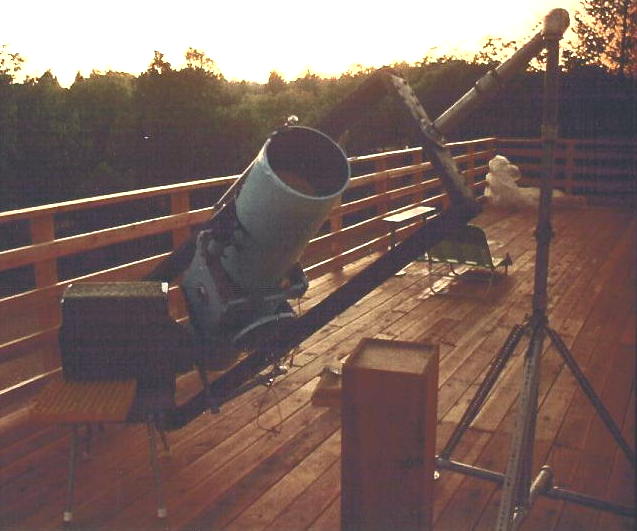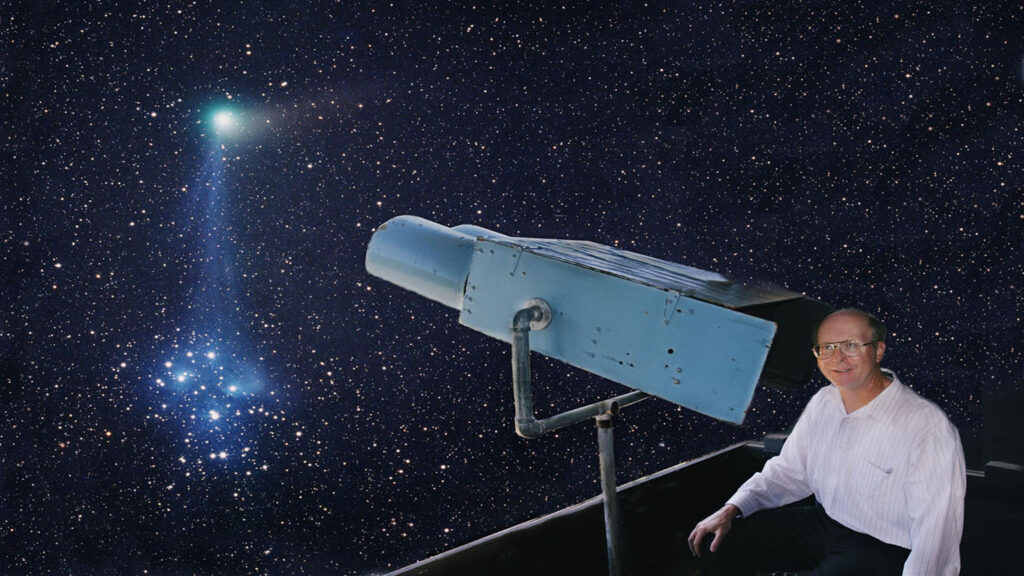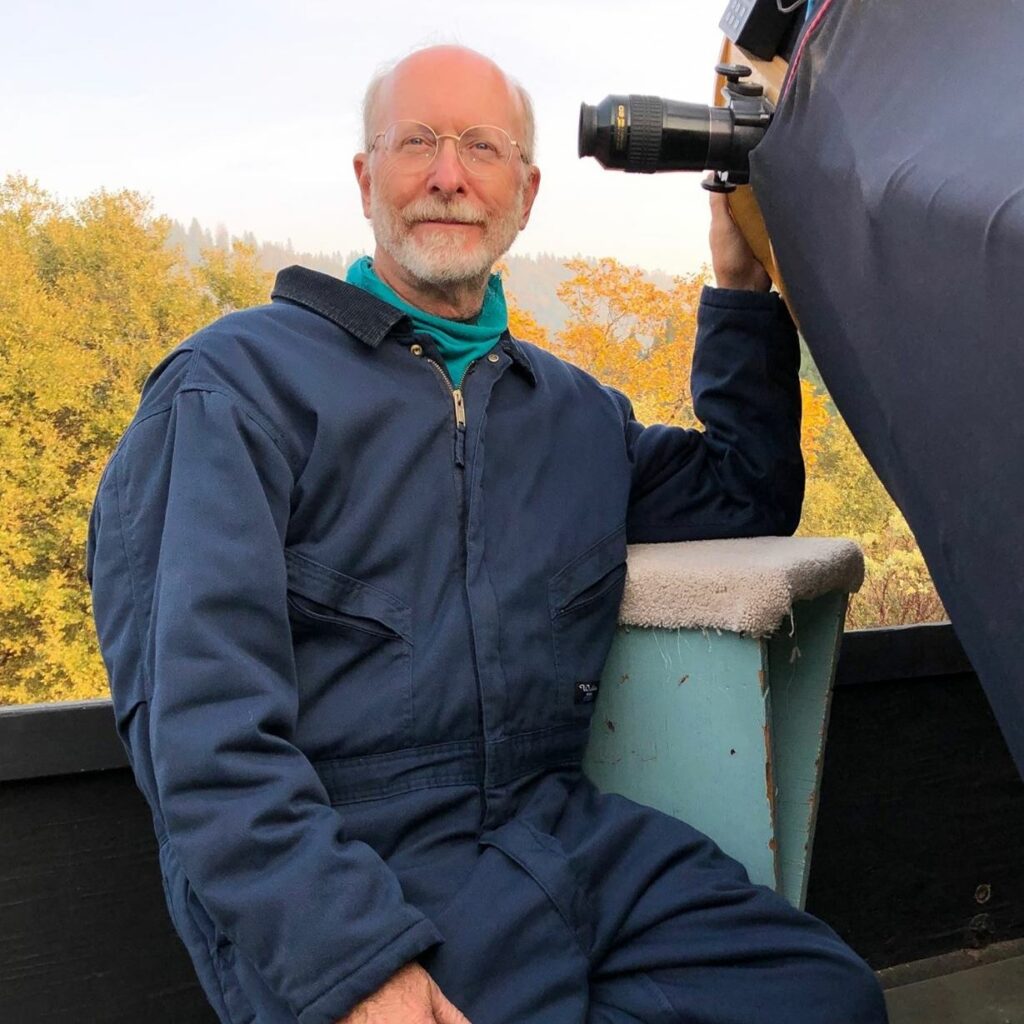The Discovery of Comet Machholz, 1992k
by Don Machholz
After I discovered Comet Tanaka-Machholz (1992d), upon completion of a conversation with Smithsonian Astrophysical Observatory’s director Dr. Brian Marsden, he said to me: “Go out and find another comet!” Little did I know that this would not take long.
Seeking new comets was a hobby I began in 1975. It branched off my interest in astronomy dating from 1965 when I received, on my thirteenth birthday, a two-inch refractor telescope. My first two nights with the scope were disappointing. I almost gave up on the hobby. But viewing Saturn on the evening of October 10, 1965, encouraged me to continue using the telescope and learn more about the sky.
I found my first comet in 1978, after searching for 1700 hours. Comet Machholz, 1978L (C/1978 R3 (Machholz)) remained faint and left the solar system, never to come back. My second comet, C/1985 K1 (Machholz) found at the Riverside Telescope Makers’ Conference at Big Bear, CA on May 27, 1985, took another 1742 hours to find. At this time, it was the longest amount of searching ever known to discover a comet. That comet remained visible for a month. It then disintegrated as it neared the sun.
My next comet, Period Comet Machholz (P/96 (Machholz)) took just under one year and 173 search hours to find. A very unusual comet, it returns every 5.2 years. It passes very close to the sun, then it races out to Jupiter’s orbit, where large telescopes can continue to track it. It returned to our part of the solar system in July 1991. I was able to observe it for a few nights. My fourth comet, Comet Machholz 1988j (C/1988 P1 (Machholz)) was visible for about three weeks before it too disintegrated as it neared the sun. It had taken 460 hours to find and was my last comet find from the Santa Cruz Mountain area. My fifth comet came nearly three years later while sweeping from Colfax, CA. It was also seen by a Japanese comet hunter a week before my discovery but was not confirmed until I saw it. It is now known as Comet Tanaka-Machholz and it performed well, remaining visible for three full months.

For discovering Comet Tanaka-Machholz, my mother gave me $20.00. I said to her: “what is this for?” She said: “for finding the comet, I’ve always given you twenty dollars for finding a comet”. For the life of me, I could not remember receiving money from my parents for finding a comet, but I did not want to argue, so I took the money.
Times were tough. I decided to use the money to further my hobby of comet hunting. The most that I could do, I figured would be to permanently mount a large pipe in the ground where one of my observatories later would be built. I was then thinking of building two observatories, one for the big binoculars and the other for my 10” telescope. I would later build only one observatory to house both instruments, but that is a different story. My idea now was to use this planted pipe to hold a telescope or the binoculars, and later the new observatory could be built around it.

I figured my best bet would be to dig a hole and stick a long pipe into it with about three feet of the pipe remaining above the ground. I searched far and wide for a 3” diameter pipe. All over Colfax, California, I asked people if they had an old pipe they did not want. Finally, Tom Sierra directed me to one of his yards, where I was able to have a five-foot length of pipe. I brought it home and painted it, then dug the hole and cemented in the pipe. Initially, I mounted the 5” refractor on it, the same instrument which I had used to discover the previous comet. In over 4,900 hours of comet hunting spanning 17 years, I had never searched for comets from a permanent mount. Everything I had used in the past had been on a portable mount. And the cost for the pipe, the pipe fittings, and the cement were under twenty dollars.

In early June I removed the 5” refractor and placed my 5” homemade binoculars onto the mount. The binoculars are heavy, weighing 120 lbs, and mounting them on the pipe was not easy. The binoculars are better at finding comets than the refractor, but a bit slower. With the binoculars, I had found my comets in 1986 and 1988.
Times became tougher in late June when I was told that my services were no longer needed as an assistant manager at Little Caesars. Not only were there no general manager positions open at the four-store system, but no openings were anticipated as they had been when I was hired three months before. I could no longer work as an assistant manager; the owners were using the hourly workers for those responsibilities. I was a manager without a store, and I was excess.
So, my last day of work was Saturday, June 27. My new job was to find a new job. This began on Monday, June 29. The days would be spent looking for employment in an area and at a time that jobs were scarce. This is one of the few times in my life when I was unemployed.
During the nights my comet hunting continued. Clouds hampered observing tor the last three nights of June, but the morning of July 1 I got out for nearly an hour before clouds came in. I decided to try an all-nighter that evening. This is rare, in 17 years of comet hunting I had probably done fewer than a half-dozen all-nighters. With the shorter summer nights, this should be something that I could do.

The evening of Wednesday, July 1 began at 10:05 PM with comet hunting using the 10-inch reflector telescope set up on our deck. For years I would wear my special comet hunting clothes for these sessions, they were especially warm and had lots of pockets. But tonight, I wore my regular “day” clothes, with my one-piece warm suit over them.
I picked up a lot of faint galaxies in the northwestern part of the sky. By 2:25 AM I had finished my work with the 10”. I packed my maps, radio, eyepieces, and flashlight into a five-gallon bucket and walked one hundred feet to the 5” binoculars on the permanent mount. Lassie, our dog, followed me and went to sleep on the blanket I had placed at my feet.
I then swept the north polar region, covering more area than I had planned, taking longer than expected. I had intended to begin sweeping the eastern sky by 3:30 AM, this would give me about 40 minutes before twilight would bring the end to a long night of comet hunting. As it turned out, I didn’t swing over to the eastern horizon until 3:50 AM.
Normally I make my first horizontal sweep rather high in the sky, with each sweep going lower until I get to the horizon. But this morning, with very little time left, I instead began at the horizon, and after each horizontal sweep, I moved upward. I recall how veteran Australian comet hunter William Bradfield had stated that this is how he sweeps the morning sky. Many years ago, I studied this method and determined that it has its advantages and disadvantages. Some zones in the morning sky are seen better, some aren’t. With this in mind, I began right along the distant tree line with my first sweep. Because my observing seat wasn’t high enough for me to comfortably see through the binoculars, I placed one of my star atlases on the bench and sat on it for more height.

Shortly after beginning my fourth sweep, while I was working southward, I picked up a circular fuzzy object. After putting on my glasses, sighting along with the binoculars (which had no finder scope), and realizing what part of the sky I was in, I knew that this was a new comet. The radio was playing the song “Crying” by Don McClean. It was 4:01 PDT.

I now had to determine the exact position of the comet so that I could properly report it to the Central Bureau for Astronomical Telegrams at the Smithsonian Astrophysical Observatory (SAO) in Cambridge, MA. This did not take long, in ten minutes I had it plotted on my atlas. I then made a large scale drawing to try to determine motion in reference to the background stars as I do for all potential comets, but as of this writing, in early 2020, I have not been able to locate that drawing. It would typically be on the back of my “At the Telescope” log sheet, but it is not there. It is possible that I did not in fact make a large-scale drawing to check for motion, as time was short and it was more important to get an accurate position for it off of the star atlas and show it to Laura than to check for motion.
Dawn was approaching so I had to hurry. My 6” telescope was already set up next to the house. I went to it and quickly found the comet in that instrument. I then went into the house and awoke my wife Laura, but my son Matthew, aged 6, was too sleepy to get up. Laura joined me at the 6-inch scope and saw the comet, at about magnitude 9, although it was difficult in the twilight.
I did not detect any motion of the comet in the 35 minutes that I was able to observe it (it would have moved about 1.5 arcminutes “downward” during those 35 minutes). I did know that it was a comet and I had to report it. So, I phoned Dr. Brian Marsden at the SAO. No one had reported an object here, and now it was just a matter of confirming it. I expected clear skies the next morning.
However, high clouds came in the next morning and covered the eastern part of the sky. After an hour of searching through the holes in the clouds, I finally picked up the comet in the twilight sky. I got only a rough idea of its position, but it had moved about a degree. I phoned the SAO, and at that time I was the only person to confirm the comet. Later a report was received from Alan Hale, who, alerted in New Mexico about my find, confirmed the comet. It was announced later in the morning.
The comet, Comet Machholz 1992k (C/1992 N1 (Machholz)), was headed towards the sun. It was on the far side of the sun as seen from the earth. I was able to observe it nearly every morning through July 10. July 11 and 12 were cloudy, and when I resumed observing it on July 13, I could no longer see the comet. When I had discovered it on July 2, it was 30 degrees from the sun and 11 degrees above my northeastern horizon. By July 13 it had moved south and towards the sun and was lost in the morning twilight. In all, I observed it on five mornings, then had 26 unsuccessful attempts to see it, with my last attempt on August 25, 1992. Of all my comet discoveries, this was probably the least observed by anyone.
Due to its low attitude, accurate positions of the comet and a determination of its orbit were slow in coming. Through the first week following the discovery, the SAO was calculating the orbit from Hale’s and my positions and our positions do not have the accuracy of the professional observatory’s photographs. Finally, after nine days, enough accurate positions were secured to publish an orbit. It showed that the comet was closest to the sun on July 11 at 0.8 astronomical unit (slightly inside the earth’s orbit) and that it was unlikely to return. However, with only a handful of comet positions to work with, the orbit calculation is not as accurate as is secured for comets observed over a larger arc. The eccentricity, or shape of the orbit, was calculated to be only 1.0, accurate to one decimal place, with still some uncertainty of the eccentricity. My two disintegrated comets (1985 and 1988) also have such an orbit. Finally, in 2010 I discovered my eleventh comet, it too has an eccentricity that is uncertain. Any of these four comets (remnants could have been leftover from the disintegrated comets) could in fact return someday, and the orbital calculation would tie them in with the comets originally discovered by me.

For about a week, three of my six comets were visible. I saw both 1992d and 1992k on the morning of July 8. They were as close as 18 degrees from each other in late April when 1992k had not yet been discovered. Meanwhile, my periodic comet was visible in very large telescopes. Of the three remaining comets that I had discovered two had disintegrated and one was in an orbit carrying it out of the solar system.
Comet 1992k was found 61 search hours and three months following my find of Comet 1992d. It was my third find with the binoculars, and my second find from Colfax, California.
End.
























